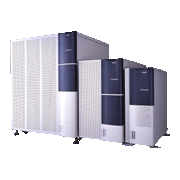Mitsubishi Electric announced the new Entrance series of servers in September 2000. These server models gave seamless coverage of e-business and mission-critical applications in one unit.
The Entrance Series implemented an application integration hub (AIH), which connected mission-critical applications, e-business applications, and data-warehouse applications by means of an XML-based request broker, known as an Internet integration broker (IIB). Making use of AIH, Entrance models offered a rich repertoire of solutions, which utilized open database systems such as Oracle 8i and SQL Server, from Web front-end systems to back-end data warehouses, such as Internet information delivery systems, Internet order-taking systems, and Web application development and execution environments.
Entrance servers achieved a dramatic increase in performance by running e-business and mission-critical applications on four function-specific processors, as follows:
- Integrated Windows processor (IP): An Intel processor for high-speed execution of mission-critical and information-retrieval/analysis applications in Windows NT
- Extended Windows processor (XP): An Intel processor that runs Internet applications; for security reasons, this processor is separate from the processor running mission-critical applications
- DP-XP processor (DP): A processor running the DP-UX core business operating system Mitsubishi Electric had developed for office computers
- Relational database processor GREO: A Mitsubishi Electric-developed relational database processor for sorting, generating index keys, and running database searches; can improve sorting speeds by 100 to 1,000 times compared to a system without GREO
The Entrance series consisted of the model 700, which boasted the top performance, reliability, and scalability of the series, the model 500, a compact model that rivaled the model 700 in performance, the model 300, which delivered excellent cost effectiveness, and the model200, a model that prioritized affordability.
| model 700 types 1 to 5 |
model 500 types 1 to 5 |
model 300 types 1 to 4 |
model 200 types 1 to 3 |
||
|---|---|---|---|---|---|
| Processor configuration*1 | IP | 1 (4 max.) | 1 (2 max.) | 1 (2 max.) | 1 (1 max.) |
| XP | 1 (4 max.) | 1 (2 max.) | − | − | |
| DP | 1 | 1 | 1 | 1 | |
| GREO | 1 (4 max.) | 1 (2 max.) | 1 (1 max.) | − | |
| Main memory unit | 640MB (7 GB max.) |
320MB (4.25 GB max.) |
128MB (2 GB max.) |
64−96MB*2 (1 GB max.) |
|
| Fixed disk unit | 51GB (1251 GB max.) |
18GB (680 GB max.) |
9GB (215 GB max.) |
9GB (36 GB max.) |
|
| Backup unit | Standard | Standard | Standard | Standard/optional *2 | |
| Max. number of physical lines | 74 | 58 | 30 | 1−11*2 | |
| Auto operation unit | Standard | Standard | Standard | Standard | |
| Workstations/printers | 1280/1000 | 480/384 | 128/64 | 8−64/4−32*2 | |
| UPS | Standard | Standard | External optional | External/internal optional*2 | |
| Operating systems | Windows NT 4.0,DP-UX H00 | ||||
- (*1)IP: Integrated Windows processor
XP: Extended Windows processor
DP: DP-UX processor
GREO: Relational database processor - (*2)Specification varies between model types.


